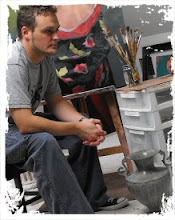Billy Seccombe
www.billyseccombe.om
https://twitter.com/wseccombe












Excerpt from blog:
These are notes I took watching Steven Assael paint. Here is a list of the colors I noticed on the palette. There were more, but these are the ones that were used frequently.
List of colors:
Burnt Sienna
Alizarin Crimson
Violet
Ultramarine blue
Prussian Blue
Cadmium green light
Viridian
Burnt umber
Ivory black
Transparent oxide red
Holbein brown pink
Transparent yellow ochre
Yellow ochre
Cadmium red light
Cadmium orange
Cadmium Yellow
Naples Yellow light
Brilliant Yellow light
Titanium White
Steve makes these colors work by blending on the canvas. He would often take a beaten large fan brush and slap in a highlight down the length of an arm in pure white, which would seem too light until he uses mixtures of more or less cad red, ochre and sienna and blends these without white loosely over the same arm. Next he might take a green and work out from the cool halftones in the same way. By this time he had subdued the intensity of the white and by painting all these colors over each other and mixing them together created a beautiful subtle color scheme with lots of broken color and texture. At this point he might restate his lights. This process is very loose with no respect paid to edges of form as these can be established later. Last he would model his darks. This was done with mostly sable brushes. He chose his dark color not for the way it looked but for how it would blend with the other colors already there. For instance alizarin crimson would create a luminous reddish haze when he used it. This would be great for the space between fingers or the transparent flesh in an ear but terrible for a cool blue area around the eye socket. In the cool areas he would often use a purple or a mixed dull greenish color with a bit of umber and a green or blue . When painting these darks he blends out from the darkest point I never saw him block in a chunky dark it was always a soft delicate subtle process where the finish starts to emerge.
Some frequent mixtures:
In the lights often Brilliant yellow light or naples were mixed with cad red, Alizarin or Yellow ochre for warmer colors and the same brilliant yellow could be mixed with a purple or green to cool the light areas. For richer color areas mixtures of naples or brilliant yellow with ochre, cad red or either of the siennas were used.
In the shadows he often would mix burnt siena and cad green, or burnt siena and alizarin for hot areas. Finally for the dark shadow accents he might use pthalo blue mixed with burnt sienna and alizarin.





wait, wait... does he do it on wet on wet wuthout waiting for it to dry?? I'm just curious.
ReplyDelete